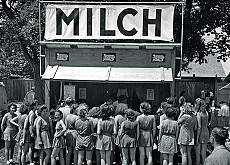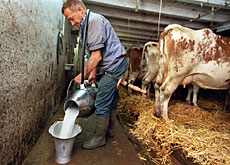The “milky way” to every Swiss door

Milk achieved its central place in Swiss identity thanks to the government's milk promotion strategy in the 20th century, according to a new history book.
“Milk for all” also explains why Switzerland once controlled a sector that it is liberalising today. After 15 years of falling prices, the cost of the drink is currently at a high.
Switzerland is firmly associated at home and abroad with cows, cheese and chocolate – all of which share a common denominator: milk.
But it was only in the 20th century that milk assumed a central place in the daily life of the Swiss, as well as importance in national politics.
Published on the centenary of the Federation of Swiss Milk Producers, “Milk for all” is available in German and French and recounts in images how milk was elevated from the position of basic foodstuff to national drink.
In the lead up to the First World War, the social climate in Switzerland was tense and fluctuations in the price of milk caused dissatisfaction among the poor. At a time when many families had trouble putting bread on the table, the authorities felt it prudent to regulate the milk sector.
In 1916 Bern gave the central union of Swiss milk producers the mandate to supply the country. Farmers, dairies, cheese dairies – who until then had been competing against each other – transformed themselves into instruments of market regulation.
“There was therefore a political consensus that the population should be able to drink milk every day. The distribution network was put in place according to public service logic,” said Peter Moser, director of the Archives of Rural History and co-author of the book.
Revolution
The images in the book say a lot about the evolution in the standard of living and consumption habits of the Swiss. With the advent of pasteurisation in the 1950s, the selling of milk underwent a revolution.
Milk suddenly became a conservable product thanks to carton packaging. The retail chain Migros, which was undergoing rapid expansion, took full advantage of this and shoppers would go to its stores daily to buy fresh milk.
By the middle of the 20th century, advances in technology were affecting the whole milk sector. Cows were “improved” and village dairies replaced with large central collection and distribution points, while cheese dairies organised resistance against industrialisation.
In a system designed to ensure general supply, the question of oversupply eventually became an issue. “Up to the First World War milk was very rare and hence there was no need for advertising. By contrast after the war there was excessive production and it became necessary to advertise,” Moser said.
Propaganda
“Drink milk!” is the message of a billboard dating from 1922, the same year that the milk industry created a “propaganda centre”.
This was the beginning of a far-reaching campaign which included tasting stands, posters, newspaper adverts and films – all promoting the benefits of milk and aimed at making it the national drink.
Starting in the 1930s, milk was distributed at schools and in the army, and was offered to the public at festivals and even on train platforms.
The slogan “Strong men drink milk” was seen throughout the country in the 1960s. But the notion of giving milk to schoolchildren began to be criticised. Some doctors said milk intake was bad for children’s appetites.
“In the past, Switzerland judged it necessary to regulate a sector which is today going through liberalisation. That’s because society has low tolerance for price increases when it is a question of survival. The debate could change again in the future, ” Moser said.
swissinfo, Carole Wälti
Per person, Swiss residents annually consume:
79 litres of milk
17.8 kilos of yoghurt
7.8 litres of milk drinks
6.1 litres of cream
5.6 kilos of butter
The state first intervened in the Swiss milk market to avoid tensions between farmers and workers over the fluctuating price of milk.
During the First World War the Swiss government fixed a price for the farmers delivering milk and a sales price.
The production, processing, sale and consumption of milk were controlled and rationed by the state during the two World Wars.
At the end of the 1970s the government introduced a quota system, which meant closer control over milk production.
In 2003 the Swiss parliament decided to abolish the quota system in stages. The Swiss milk market will be fully liberalised by 2009.
A cow consumes about 100 kilos of grass, 2.5 kilos of concentrates (cereals), 200 grams of salt and 50 litres of water a day.
That allows her to produce on average 24 litres of milk a day. The transformation of grass into milk takes two to three days.
Depending on breed and diet, a cow can give 5,000-10,000+ litres of milk a year.

In compliance with the JTI standards
More: SWI swissinfo.ch certified by the Journalism Trust Initiative











You can find an overview of ongoing debates with our journalists here . Please join us!
If you want to start a conversation about a topic raised in this article or want to report factual errors, email us at english@swissinfo.ch.